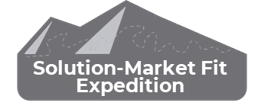Solution-Market fit expedition
The purpose of this expedition is to transform viable innovation initiatives into business outcomes reflecting successful early adoption (i.e. “business traction”) as well as into learnings about how the solution should be built, how value should be created and delivered to customer/stakeholders and how value could be captured by the organization.
The innovation initiatives achieving business traction are then scaled up and optimized in the next expedition: the Business Model Conquest.

Description
A common pattern in this expedition is that one or several teams are formed to develop, test and validate a hypothesized minimal marketable solution (MMS) of each selected business concept with potential early adopters (e.g. potential external users/consumers or internal customers within an organization).
Teams do this by building and integrating a working solution in an agile way. They build and deliver value incrementally and often to customer/stakeholders in order to measure behaviors, learn what works and what doesn´t and adjust accordingly in the fastest way possible. A team continue learning until traction is achieved as indicated by innovation accounting metrics.
The number of teams and their mix of knowledge and skills will depend mainly on the complexity of a solution concept (e.g. a cyber-physical system concept with a variety of digital and physical components will probably require several teams, each one focused in a major component or functionality). In general, a solution should be architected to allow speed of delivery and responsiveness to change.
Toolkits (“Exploration Backpacks”)
The team can accomplish outcomes by selecting activities and tools for the purpose, especially from the “implement” backpack, which include marketing practices for customer acquisition as well as technical practices involving physical (hardware) and digital (software) components. Among the practices are architecture practices at enterprise and solution levels; DevOps practices for automation, telemetry and recovery; and quality practices such as agile architecture, agile testing, behavior-driven development, test-driven development, refactoring, code quality, frequent system-level integration, design verification, Model-Based Systems Engineering (MBSE), and Set-Based Design.
These tools enable a team to apply systems thinking and develop, test, integrate and deliver a solution with the quality attributes that customers and other stakeholders desire, as well as to collect data on the performance and use of the solution, thus contributing to attract, convert, delight and retain an increasing quantity of early adopters. This marks the key broad milestone for this expedition, identified in the model as “business traction”.
